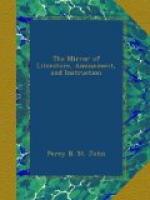II.
Couch’d in the bosom of a bounteous
vale,
The ancient city, to the enamour’d
sight,
Gleams like a vision of the
fairy night,
Or Be-ulah, in Banyan’s holy tale.
The silvery clouds that o’er the
valley sail
Dim not the sinking sun, whose
lustre fires
The old cathedral and its
gorgeous spires,
The ruin’d abbey, garlanded and
pale
The vesper choristers in each lone wood
Chant to the peeping moon
their serenade;
Now creeps the far-off forest
into shade,
And twilight comes o’er heath, and
field, and flood.
Oh! had I genius now the task to try,
My picture should Italian Claude’s
outvie!
* * H.
[1] Henry the Second.
* * * * *
MOUNT ST. MICHAEL.
(To the Editor.)
In no. 477 of the Mirror you have given a spirited engraving of Mount St. Michael, with a succinct account annexed, to which the following particulars may serve as addenda:—
Its most ancient name was Belinus, when it was inhabited by Druidesses. After the abolition of the Druids, it took the name of Mons Jovis; to which was substituted that of Tumba, when a monastery was erected upon it. In 708, Bishop Auber raised upon it a church, which he dedicated to St. Michael.—Ethelred, the second, of England, had a particular veneration for Mount St. Michael. Abbot Roger had been almoner to William the Conqueror. Henry II. of England made a pilgrimage to Mount St. Michael, when he met Louis VII. King of France, with a splendid suite.
In 1203 the fortifications consisted only of wooden palisades. Being attacked by the Bretons, they set fire to them: the fire reached the church and abbey, which was completely destroyed. The monastery was restored in 1226, by Abbot Adulph de Villedieu. His successor, Richard Justin, obtained from the Pope the most distinguished privileges.
In 1418 the English made a fruitless attack upon it.
In 1423 it was attempted again, with a very considerable force and powerful artillery, two pieces of which now stand at the main gate: one has a stone ball in it of about fifteen inches diameter. Among the distinguished English officers who perished at the siege, was a Chevalier M. Burdet.
In 1577 a Protestant chief (Dutouchet) succeeded by stratagem in getting possession of it. After two day’s possession, he was obliged to evacuate it.
In 1591 a similar attempt proved most destructive to the assailants.
In 1594, the spire, the bells, and the church, were considerably injured by lightning.
Mount St. Michael was visited in 1518 by Francis I. of France; in 1561, by Charles IX.; in 1576, by the Duchess de Bourbon; in 1624, by the Duke de Nevers, who made a rich present to the abbey; in 1689, by Madame de Levigne, who designated it Le Mont fier et orgueilleux. In 1689, Philip Duke of Orleans, brother to Louis XIV., was one of its visiters.




